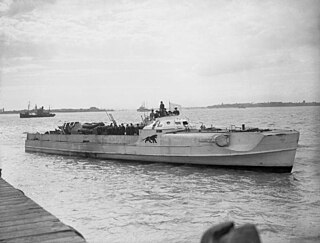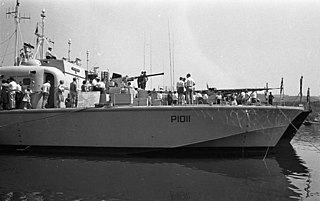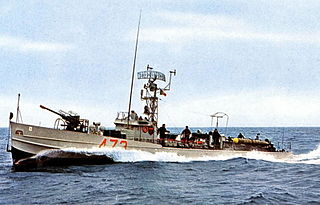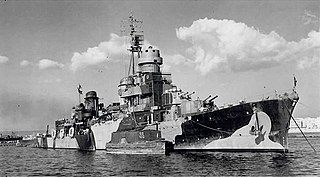Related Research Articles

A motorboat, speedboat or powerboat is a boat that is exclusively powered by an engine.

E-boat was the Western Allies' designation for the fast attack craft of the Kriegsmarine during World War II; E-boat could refer to a patrol craft from an armed motorboat to a large Torpedoboot. The name of E-boats was a British designation using the letter E for Enemy,

A motor torpedo boat is a fast torpedo boat, especially of the mid 20th century. The motor in the designation originally referred to their use of petrol engines, typically marinised aircraft engines or their derivatives, which distinguished them from other naval craft of the era, including other torpedo boats, that used steam turbines or reciprocating steam engines. Later, diesel-powered torpedo boats appeared, in turn or retroactively referred to as "motor torpedo boats" for their internal combustion engines, as distinct from steam powered reciprocating or turbine propulsion.

MTB 102 is one of few surviving motor torpedo boats that served with the Coastal Forces of the Royal Navy in the Second World War. She was built as a prototype, but was purchased and taken into service by the Admiralty.

The motor gun boat (MGB) was a small, high-speed British military vessel of the Second World War, which was armed with a mix of guns, in contrast to the physically similar motor torpedo boat (MTB), whose main offensive weapon were torpedoes. The small size of the MGBs, and their high speed, made them difficult targets for German E-boats, though, like their opponents, they were limited by heavy weather, because they did not provide a stable-enough platform to aim the guns. The large number of guns meant the crew was relatively large, numbering as high as thirty men on the largest boats.

A fast attack craft (FAC) is a small, fast, agile, offensive, often affordable warship armed with anti-ship missiles, gun or torpedoes. FACs are usually operated in close proximity to land as they lack both the seakeeping and all-round defensive capabilities to survive in blue water. The size of the vessel also limits the fuel, stores and water supplies. In size they are usually between 50–800 tonnes and can reach speeds of 25–50 knots (46–93 km/h).

The Type 142 Zobel class was a German class of torpedo bearing fast attack craft. They were in service with the Bundesmarine during the Cold War to protect the Baltic sea coast. The class was designed by Lürssen.
The Naval Service is the maritime component of the Irish Defence Forces. It was initially formed in 1923, as the Coastal and Marine Service (CMS), a small organisation manned mainly by personnel who had come from the merchant navy. The CMS was disbanded in 1924 and, until 1938, a limited fisheries protection function was operated under the Department of Agriculture and Fisheries. The Marine and Coastwatching Service was established in 1939, and operated as a mine laying, shipping regulation and fishery protection throughout the period of Ireland's neutrality during World War II. In 1946, the Marine Service was integrated with the land and air elements of the Defence Forces, forming the genesis of the modern Naval Service.

The Brave-class fast patrol boats were a class of two gas turbine motor torpedo boats (MTBs) that were the last of their type for the Royal Navy (RN) Coastal Forces division. They formed the basis for a series of simpler boats which were widely built for export.

The Fairmile D motor torpedo boat was a type of British motor torpedo boat (MTB) and motor gunboat (MGB) designed by Bill Holt and conceived by Fairmile Marine for the Royal Navy. Nicknamed "Dog Boats", they were designed to combat the known advantages of the German E-boats over previous British coastal craft designs. They were bigger than earlier MTB or motor gunboat (MGB) designs but slower, at 30 knots compared to 40 knots.

Coastal Forces was a division of the Royal Navy initially established during World War I, and then again in World War II under the command of Rear-Admiral, Coastal Forces. It remained active until the last minesweepers to wear the "HM Coastal Forces" cap tally were taken out of reserve in 1968. On 21 May 2020, ministerial approval for the change in name from 1st Patrol Boat Squadron to Coastal Forces Squadron was given. It encompasses the Archer-class patrol vessels and the Batch 1 River-class offshore patrol vessels and are responsible for UKEEZ Protection and Patrol.

Steam gun boats (SGBs) were small Royal Navy vessels built from 1940 to 1942 for Coastal Forces during the Second World War. The class consisted of nine steam-powered torpedo boats.

The Coastal Forces of the Royal Canadian Navy (RCN) was a specialized naval force of well-armed, small and fast motor launch (ML) and motor torpedo boat (MTB) flotillas, primarily manned by members of the Royal Canadian Naval Volunteer Reserve (RCNVR). Tasked with escort, coastal defence, anti-submarine, minesweeping and search and rescue duties, the Coastal Forces of the RCN contributed to securing Allied sea lines of communication off the coasts of Canada and Britain during the Second World War.

Coastal Motor Boat was a small high-speed British torpedo boat used by the Royal Navy in the First World War and up to end of the Second World War.

The Gay class were a class of twelve fast patrol boats that served with the Royal Navy from the early 1950s. All were named after types of soldiers or military or related figures, prefixed with 'Gay'. The class could be fitted as either motor gun boats or motor torpedo boats, depending on the type of armament they carried.
HMSAS Parktown was a minesweeping whaler of the South African Naval Services that was sunk during the Second World War. She was built as the whaler Southern Sky for the Southern Whaling and Sealing Company in 1929 and sold in 1936 to the Union Whaling Company, acquiring the new name Sidney Smith. She was requisitioned on 8 August 1940 as HMSAS Parktown and was converted to sweep magnetic mines. She arrived at Tobruk on 10 June 1942 just in time to take part in the evacuation of Allied forces. She was the last ship to leave Tobruk harbour prior to its capitulation to German forces on 20 June 1942. Parktown embarked 60 troops and took a tug in tow outside the harbour. Her reduced speed led to her being attacked by German E-boats, most probably German E-boats from Derna. Gunfire from the motor boats destroyed the bridge, ruptured the boiler, killed or wounded half of the men on board and led to on-board ammunition exploding, causing her to finally stop moving and setting the ship on fire. She was finally sunk on the evening of 21 June 1942 by an Allied MTB which had arrived to pick up survivors.

The Motosilurante CRDA 60 t was a type of motor torpedo boat built for the Regia Marina during World War II. It was designed on the pattern of German S-boats — some early examples of which were captured by the Italians from Yugoslav Navy — to complement the faster but less seaworthy MAS boats.

Operation Scylla was the transit of the Regia Marina Capitani Romani-class light cruiser Scipione Africano on the night of 17/18 July 1943, during the Second World War. The cruiser sailed from La Spezia in the Tyrrhenian Sea to Taranto in the Ionian Sea during the Allied invasion of Sicily.

Splinter fleet or Splinter navy was a nickname given to the United States wooden boats used in World War II. The boats served in many different roles during the war. These boats were built in small boatyards on the West coast and East coast, Great Lakes and the Gulf of Mexico. They could be built quickly, in just 60 to 120 days. Most of the boats were built by boatyards that already had the tools and knowledge from building yachts, sailboats and motor boats. Many were built by craftsmen in family-owned small businesses. Under the Emergency Shipbuilding Program and War Shipping Administration contracts went out to over fifty boatyards across the country. The boats were built for the US Navy, the United States Army Air Forces, United States Coast Guard, and US Army. Some of the wooden boats went to Allied nations on the Lend-Lease program.
References
- ↑ Sendall, Bernard Independent Television in Britain: Volume 2 - Expansion and Change 1958-68 London: The Macmillan Press Ltd 1983 ISBN 0-333-30942-1, Chapter 35, "Technical Background", p326-327
- ↑ Brockman, David (2005). "From the South". transdiffusion.org. Archived from the original on 21 October 2009. Retrieved 10 February 2010.
- ↑ Various (2005). "Forum posts under topic "MTB 506"". British Military Powerboat Trust. Retrieved 10 February 2010.